White Sewing Machine
The White Sewing Machine was the first sewing machine from the White Sewing Machine Company.[1] It used a vibrating shuttle bobbin driver design; for that reason, and to differentiate it from the later White models that used a rotary hook design instead, it came to be known as the "White Vibrating Shuttle" or "White VS". In 1879 it cost USD50 to US$125 (US$1097 to US$2744 adjusted) depending on which table or cabinet it was to be mounted in.[2] The White VS continued in production, with improvements, until the early 1900s.
.jpg.webp)
There was also a 3/4-sized version called the "White Peerless".
Production
Versions
The White VS evolved over time through these versions:
| Year | Model | Shuttle | Picture | Notes |
|---|---|---|---|---|
| 1876–1882 | Model A (VS I) | boat |
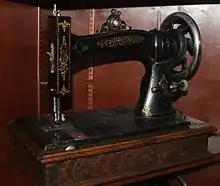 |
round tension control on upper arm, manual bobbin winder |
| 1882–1886 | VS IIa | boat | ? | round tension nut on lower head without dial |
| 1886–1889 | VS IIa | bullet | 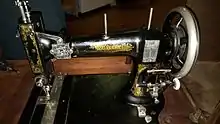 1886-1889 White VS IIa Treadle Sewing Machine. Upper tension knob has no dial. |
round tension nut on lower head without dial |
| 1889–1892 | VS IIb | bullet | ? | round tension nut on lower head without dial |
| 1893–1928 | VS III | bullet | 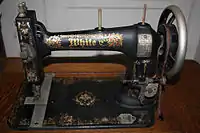 |
round tension control on upper head with dial |
Portable versions
White developed a 3/4-sized version for the sake of portability, exactly as Singer was developing the 3/4-sized model VS-3/28/128. It was called the 'Peerless' and its evolution tracked that of its full-sized parent:
| Version | Based on | Picture | Notes |
|---|---|---|---|
| Peerless | VS I | 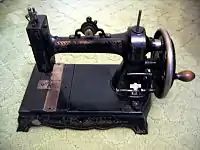 |
tensioner mounted on upper arm like the VS I |
| White Peerless | VS IIa or IIb | ? | tensioner mounted on lower head like the VS IIa and IIb |
| New White Peerless | VS III | 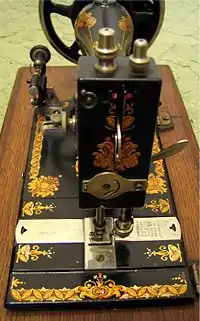 |
three variants produced—A, B, and C – differing in case and hand-crank. |
| Gem | Unique design. | 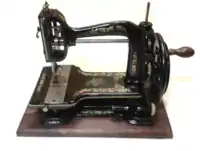 White Gem Sewing Machine from about 1886 |
very small, and very different from the VS and Peerless |
Shuttle changes
The first versions of the White Sewing Machine [4] used a "boat" shuttle that was comparable to those used in contemporary transverse shuttle machines. In 1886 the shuttle was changed to a bullet shape, with a thin rod in the interior upon which the bobbin rotates. The change was probably prompted by the bullet shuttle used in the new Singer Vibrating Shuttle machine, invented the year before, itself a derivative of the White machine. Still later, the shuttle was refined again for the Peerless machines.
| Version | Shuttle | Part number |
|---|---|---|
| VS I, VS IIa | 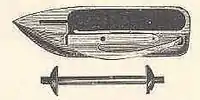 |
85 (body), 94 (bobbin)[5] |
| VS IIa |  |
? |
| VS IIb |  |
282 (body), 321 (bobbin)[6] |
| VS III | original shuttle used 1893-1900 | 349 (assembly), 321 (bobbin)[7] |
 "New Shuttle" used 1900 onward |
? | |
 New White Peerless shuttle |
1554 (assembly), 321 (bobbin)[8] |
Badged variants
White produced VS machines under several different badges, in addition to the Peerless. These included 'Franklin' (same name as a Singer model 27 clone produced later), 'Mason D', 'Minnesota E', and 'Queen'.
History
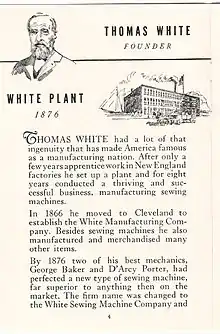
D'Arcy Porter and George W. Baker designed the machine and are named as inventors on most of the six[9] original US patents, dated 1876–1877, that cover it.[10] The company literature would later look back adoringly on them, calling them "two of [White's] best mechanics" who had "perfected a new type of sewing machine, far superior to anything then on the market".[11]
At the time of its development, the machine was the White Sewing Machine Company's flagship product—so much so that it was simply named the "White Sewing Machine". Only later it was called the "White Vibrating Shuttle", when a rotary hook model named the White Family Rotary was added to the product line.
References
- >"Grand Opening", Cleveland Herald 1878-12-26, reprinted in "Ready Reference Atlas and Almanac" (1879) published by the White Sewing Machine Company, retrieved 2010-09-07
- "Ready Reference Atlas and Almanac" (1879), "Retail Price List" (page 23), published by the White Sewing Machine Company, retrieved 2010-09-07
- "Directions for Using the New White Peerless Sewing Machine", differential parts lists on last pages
- Sewing machine reviews - advice and tips on all sewing machines
- "Illustrations and Directions for Using the White Sewing Machine and Its Attachments", retrieved 2010-09-07
- "Directions for Using the White Sewing Machine and Its Attachments, Book 4, page 13, retrieved 2010-09-07
- "Instructions for Using the White Sewing Machine, page 13, retrieved 2010-09-07
- "Directions for Using the New White Peerless Sewing Machine", parts list on last page, retrieved 2010-09-07
- The White Sewing Machine's patents include 174703 (drivetrain and shuttle arm), 188537 (vibrating shuttle), 188767 (drivetrain), and 194067 (stop-motion device)
- Grace Rogers Cooper, The Invention of the Sewing Machine (1968), retrieved 2010-08-05
- "Since 1876 - A Few Facts about the White Sewing Machine Company" (1941)), retrieved 2010-08-05 from the Smithsonian Museum
External links
![]() Media related to White Sewing Machines at Wikimedia Commons
Media related to White Sewing Machines at Wikimedia Commons